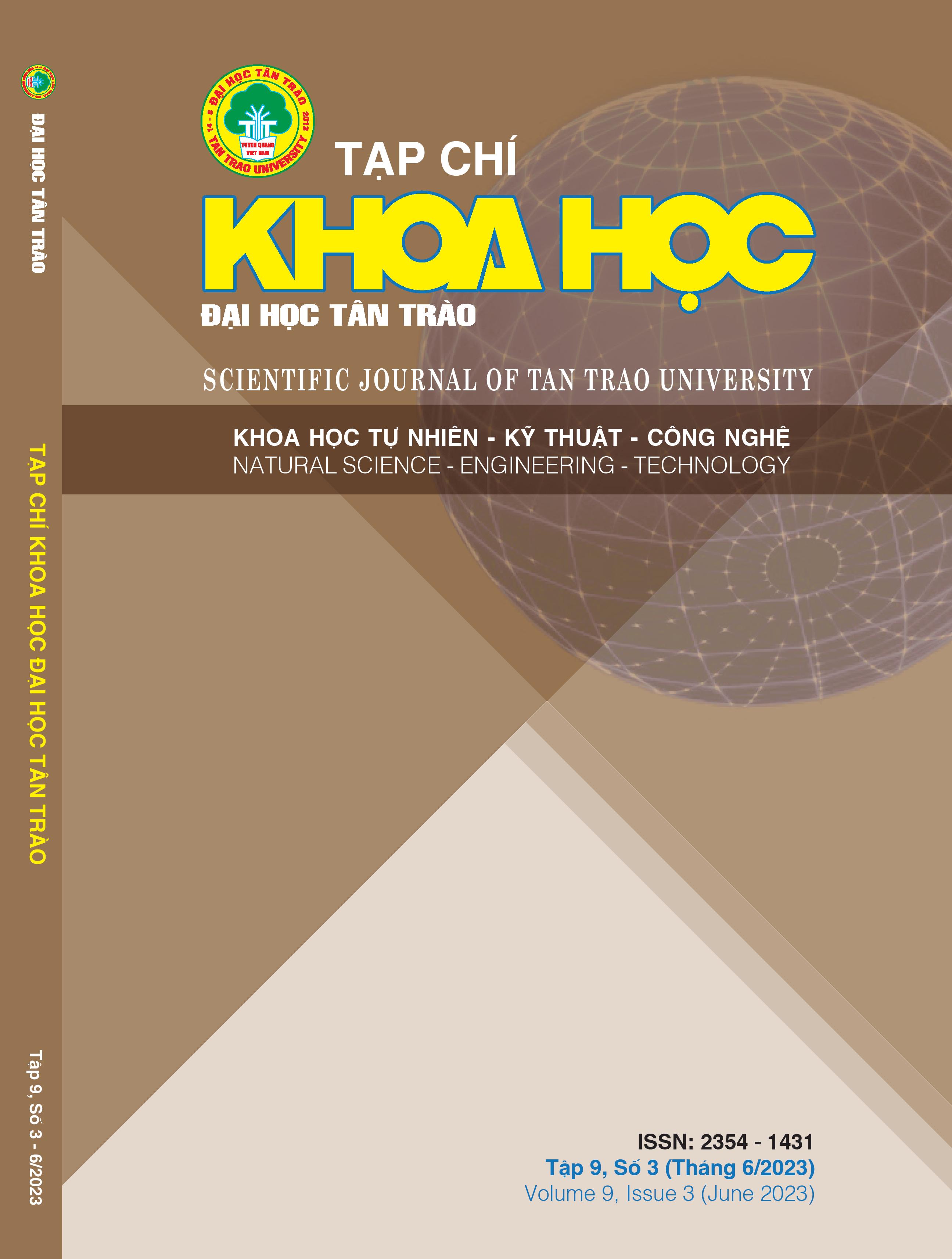MÔ HÌNH SUY HAO ĐƯỜNG TRUYỀN TRONG MÔI TRƯỜNG VÔ TUYẾN THÔNG MINH
DOI:
https://doi.org/10.51453/2354-1431/2023/971Từ khóa:
Bề mặt thông minh có thể cấu hình lại, Bề mặt phản xạ thông minh, Sau 5G, Mô hình pathloss, Môi trường vô tuyến thông minh.Tóm tắt
Bề mặt phản xạ thông minh là một công nghệ mới đang được nghiên cứu, triển khai để phát triển các hệ thống truyền thông không dây, cũng như các mạng di động 5G, sau 5G (B5G) và mạng tương lai 6G. Bề mặt chứa siêu vật liệu điện từ có thể tái cấu hình để hướng chùm sóng từ nguồn phát tới các bộ thu mong muốn với cường độ tín hiệu tối đa. Bài báo cung cấp một mô hình pathloss và kênh dẫn trong hệ thống thông tin liên lạc có sự hỗ trợ của bề mặt thông minh được xây dựng dựa trên kỹ thuật quang học vật lý và định luận phản xạ ánh sáng của Snell. Với các biểu thức toán học sẽ cung cấp cho các nhà nghiên cứu một phương án tính toán, mô phỏng, phân tích, đánh giá và hiệu chỉnh các kênh truyền thông nhằm đạt được hiệu quả tối ưu trước khi triển khai chế tạo thực nghiệm hoặc để so sánh với các công nghệ tăng cường truyền tải thông tin khác như bộ khuếch đại và chuyển tiếp AF, định dạng chùm MIMO và truyền thông tán xạ ngược BackCom.
Tải xuống
Tài liệu tham khảo
[1] M. Patzold, “It’s time to go big with 5G mobile radio,” IEEE Vehicular Technology Magazine, vol. 13, no. 4, pp. 4-10, 2018.
[2] W. Saad, M. Bennis, and M. Chen, “A vision of 6G wireless systems: Applications, trends, technologies, and open research problems,” in IEEE Network, vol. 34, no. 3, pp. 134 - 142, Oct. 2019.
[3] X. Cao, L. Liu, Y. Cheng, and X. S. Shen, “Towards energy-efficient wireless networking in the big data era: A survey,” IEEE Commun. Surv. Tut., vol. 20, no. 1, pp. 303-332, Firstquarter 2018.
[4] M. R. Akdeniz et al., “Millimeter wave channel modeling and cellular capacity evaluation,” IEEE J. Sel. Areas Commun., vol. 32, no. 6, pp. 1164-1179, Jun. 2014.
[5] Q. Wu and R. Zhang, “Towards smart and reconfigurable environment: Intelligent reflecting surface aided wireless network,” IEEE Commun. Mag., vol. 58, no. 1, pp. 106-112, Jan. 2020.
[6] M. D. Renzo et al., “Smart radio environments empowered by reconfigurable AI meta-surfaces: An idea whose time has come,” EURASIP J. Wireless Commun. Netw., vol. 2019, May 2019, Art. no. 129.
[7] E. Basar, M. Di Renzo, J. de Rosny, M. Debbah, M.-S. Alouini, and R. Zhang, “Wireless communications through reconfigurable intelligent surfaces,” in IEEE Access, vol. 7, pp. 116753 - 116773, Aug. 2019.
[8] E. Basar, “Transmission through large intelligent surfaces: A new frontier in wireless communications,” European Conference on Networks and Communications (EuCNC), 2019.
[9] Z.-Q. He and X. Yuan, “Cascaded channel estimation for large intelligent metasurface assisted massive MIMO,” in IEEE Wireless Communications Letters, vol. 9, pp. 210 - 214, Oct. 2019.
[10] X. Tan, Z. Sun, D. Koutsonikolas, and J. M. Jornet, “Enabling indoor mobile millimeter-wave networks based on smart reflect-arrays,” IEEE Conference on Computer Communications (INFOCOM), 2018, pp. 270-278.
[11] T. Ulversoy, “Software defined radio: Challenges and opportunities,” IEEE Communications Surveys & Tutorials, vol. 12, no. 4, pp. 531-550, 2010.
[12] D. Mishra and H. Johansson, “Channel estimation and low-complexity beamforming design for passive intelligent surface assisted MISO wireless energy transfer,” in IEEE International Conference on Acoustics, Speech and Signal Processing (ICASSP), 2019, pp. 4659-4663.
[13] L. Subrt and P. Pechac, “Controlling propagation environments using intelligent walls,” proc. European Conf. Antennas Propag. (EUCAP), Mar. 2012, pp. 26-30.
[14] M. Najafi and R. Schober, “Intelligent reflecting surfaces for free space optical communications,” proc. IEEE GLOBECOM, Dec. 2019, pp. 1-7.
[15] Z. Li et al., “Towards programming the radio environment with large arrays of inexpensive antennas,” in Proc. USENIX Symp. Netw. Syst. Design Implement., Feb. 2019, pp. 285-299.
Tải xuống
Đã Xuất bản
Cách trích dẫn
Số
Chuyên mục
Giấy phép

Tác phẩm này được cấp phép theo Giấy phép Quốc tế Creative Commons Attribution-ShareAlike 4.0 .
Bài báo được xuất bản ở Tạp chí Khoa học Đại học Tân Trào được cấp phép theo giấy phép Ghi công - Chia sẻ tương tự 4.0 Quốc tế (CC BY-SA). Theo đó, các tác giả khác có thể sao chép, chuyển đổi hay phân phối lại các bài báo này với mục đích hợp pháp trên mọi phương tiện, với điều kiện họ trích dẫn tác giả, Tạp chí Khoa học Đại học Tân Trào và đường link đến bản quyền; nêu rõ các thay đổi đã thực hiện và các nghiên cứu đăng lại được tiến hành theo cùng một bản quyền.
Bản quyền bài báo thuộc về các tác giả, không hạn chế số lượng. Tạp chí Khoa học Tân Trào được cấp giấy phép không độc quyền để xuất bản bài báo với tư cách nhà xuất bản nguồn, kèm theo quyền thương mại để in các bài báo cung cấp cho các thư viện và cá nhân.
Mặc dù các điều khoản của giấy phép CC BY-SA không dành cho các tác giả (với tư cách là người giữ bản quyền của bài báo, họ không bị hạn chế về quyền hạn), khi gửi bài tới Tạp chí Khoa học Đại học Tân Trào, tác giả cần đáp ứng quyền của độc giả, và cần cấp quyền cho bên thứ 3 sử dụng bài báo của họ trong phạm vi của giấy phép.






